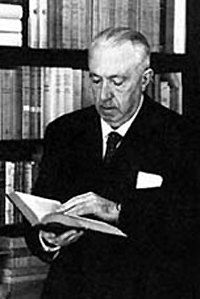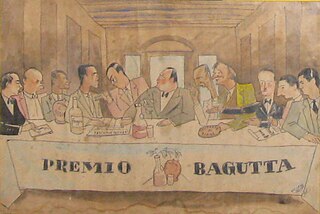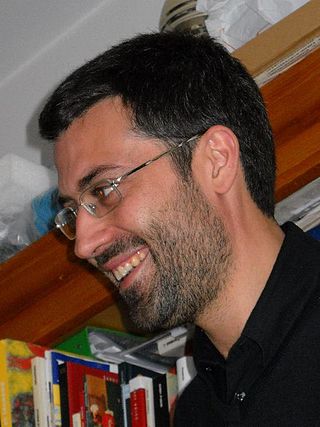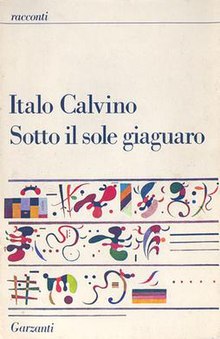
Italo Calvino was an Italian writer and journalist. His best known works include the Our Ancestors trilogy (1952–1959), the Cosmicomics collection of short stories (1965), and the novels Invisible Cities (1972) and If on a winter's night a traveler (1979).

Cosmicomics is a collection of twelve short stories by Italo Calvino first published in Italian in 1965 and in English in 1968. The stories were originally published between 1964 and 1965 in the Italian periodicals Il Caffè and Il Giorno. Each story takes a scientific "fact", and builds an imaginative story around it. An always-extant being called Qfwfq narrates all of the stories save two. Every story is a memory of an event in the history of the universe. Qfwfq also narrates some stories in Calvino's t zero.

If on a winter's night a traveler is a 1979 novel by the Italian writer Italo Calvino. The postmodernist narrative, in the form of a frame story, is about the reader trying to read a book called If on a winter's night a traveler. Each chapter is divided into two sections. The first section of each chapter is in second person, and describes the process the reader goes through to attempt to read the next chapter of the book he or she is reading. The second half is the first part of a new book that the reader ("you") finds. The second half is always about something different from the previous ones. The book was published in an English translation by William Weaver in 1981.

Carlo Emilio Gadda was an Italian writer and poet. He belongs to the tradition of the language innovators, writers that played with the somewhat stiff standard pre-war Italian language, and added elements of dialects, technical jargon and wordplay.

Italian Folktales is a collection of 200 Italian folktales published in 1956 by Italo Calvino. Calvino began the project in 1954, influenced by Vladimir Propp's Morphology of the Folktale; his intention was to emulate the Straparola in producing a popular collection of Italian fairy tales for the general reader. He did not compile tales from listeners, but made extensive use of the existing work of folklorists; he noted the source of each individual tale, but warned that was merely the version he used.
William Fense Weaver was an English language translator of modern Italian literature.

Mr. Palomar is a 1983 novel by the Italian writer Italo Calvino. Its original Italian title is Palomar. In an interview with Gregory Lucente, Calvino stated that he began writing Mr. Palomar in 1975, making it a predecessor to earlier published works such as If on a winter's night a traveler. Mr. Palomar was published in an English translation by William Weaver in 1985.

Andrea De Carlo is an Italian novelist. He has published almost two dozen novels, many of which have been translated.
How the Devil Married Three Sisters is an Italian fairy tale found in Thomas Frederick Crane's Italian Popular Tales (1885). It was collected and originally published in German as "Der Teufel heirathet drei Schwestern" by Widter and Wolf in 1866.

The Bagutta Prize is an Italian literary prize that is awarded annually to Italian writers. The prize originated among patrons of Milan's Bagutta Ristorante. The writer Riccardo Bacchelli discovered the restaurant and soon he regularly gathered numerous friends who would dine there together and discuss books. They began charging fines to the person who arrived last to an appointed meal, or who failed to appear.
"The Little Girl Sold with the Pears" is an Italian fairy tale published by Italo Calvino in Italian Folktales, from Piedmont. Ruth Manning-Sanders included a variant, as "The Girl in the Basket", in A Book of Ogres and Trolls.

t zero is a 1967 collection of short stories by Italian author Italo Calvino. The title story is based on a particularly uncertain moment in the life of a lion hunter. This second in time, t0, is considered by the hunter against known previous seconds and hypothetical future seconds

Un re in ascolto is an opera by Luciano Berio, who also wrote the Italian libretto. It is based on a short story from the collection Under the Jaguar Sun by Italo Calvino, but incorporates excerpts from Friedrich Einsiedel's 1778 libretto for an opera based on Shakespeare's The Tempest. This became Die Geisterinsel in 1798, set to music written by Friedrich Fleischmann. In addition, W. H. Auden's The Sea and the Mirror: A Commentary on Shakespeare's The Tempest was a source.

Francesco Golisano was an Italian film actor.

DamianPettigrew is a Canadian filmmaker, screenwriter, producer, author, and multimedia artist, best known for his cinematic portraits of Balthus, Federico Fellini, and Jean Giraud.
Giovanni Arpino was an Italian writer and journalist.

Andrea Bajani is an Italian novelist, poet, and journalist. After his debut with Cordiali saluti, it was Se consideri le colpe which brought him a great deal of attention. Antonio Tabucchi wrote about his debut novel, "I read this book with an excitement that Italian literature hasn't made me feel in ages." The book won the Super Mondello Prize, the Brancati Prize, the Recanati Prize and the Lo Straniero Prize.
Cesare Garboli was an Italian literary and theater critic, translator, writer and academic.

Roberto Andò is an Italian director, screenwriter, playwright and author.
Dario Voltolini is an Italian writer. His style has often been described as "minimalism", though the author describes his writing as spontaneous and far from the patiently refined work of minimalism master Raymond Carver.













